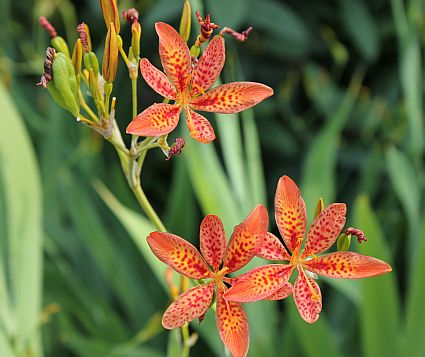[And I don’t mean “greatest hits”, I mean “Mafia hit”]
Gardeners, yardeners, and designers are on a perpetual lookout for a good hedge species. Hedges are useful in so many ways: providing backdrop for a border, making good neighbors, containing football players, etc. In reference to the latter, the field at Sanford Stadium at the University of Georgia (cue woofing!) is known as “Between the Hedges”. In the extensive lore of UGA football, everyone makes like it’s some sacred plant, but (gasp!) it’s just plain ol’ privet. Aside to Jeff, my fellow UGA alum: CNN just reported the dubious distinction that Georgia is the #1 party school in the country (again). Maybe this is why I can’t remember the Krebs Cycle.

Variegated Chinese Privet in all its shrubby glory; photo from University of Arkansas Cooperative Extension.
Back to privet. Designers of D.O.T. landscapes such as medians and interchanges seem especially enamored. Clouds of variegated privet (L. sinense ‘Variegatum’) dot interstates throughout the South. Yes, it’s tough, useful, variegated, and touted as “wildlife friendly” by some leading gardening resources. The berries are indeed good bird food; therein lies the problem. Seeds pooped out by birds results in the green, non-variegated version – much more vigorous and deposited everywhere. For the record, the variegated form also reverts like crazy.
My family’s farm in northeast Georgia is bordered by the North Fork of the Broad River. Over the years, the river bottom, and then the fence lines at all elevations, have filled with privet. It is, pardon my language, a total bitch to remove and almost impossible to eradicate. The State Botanical Garden of Georgia in Athens has an entire squad dedicated to eliminating it from acres of river bottom; ironically, only a few miles from Sanford Stadium. Thought of mostly as a Zone 7-9 plant; we have lots of it in the woods here in the mountains – an entire zone cooler.

Distribution of L. sinense; USDA PLANTS Database http://plants.usda.gov/
Ligustrum sinense is on at least two official Invasive and Noxious Weeds lists by the Southeast Exotic Pest Plant Council and Florida Exotic Pest Plant Council as well as several international lists. Nursery growers and landscapers across the South know these things. So why, why, why, do they continue to produce and spec it? “Variegated foliage sells. People see it, like it, and then ask for it. It’s a bread-and-butter item.” This comment came from the owner of a fairly large nursery that sells to independent garden centers.
Our industry yelps whenever a state or federal mandate threatens to impose restrictions on a best-seller (Hedera helix, for recent example). There are LOTS of terrific woody plants out there, people. The Dirr book is now up to 1250 pages – thumb through and pick a few alternatives. Cease and desist with the Chinese privet.


















